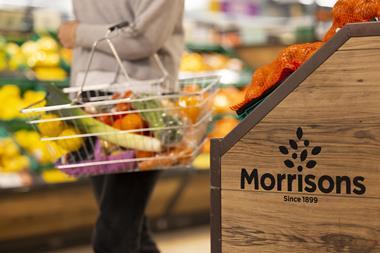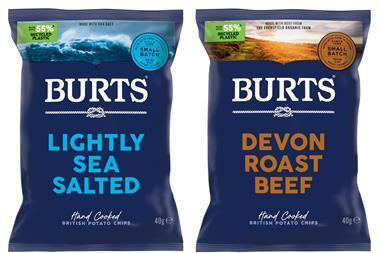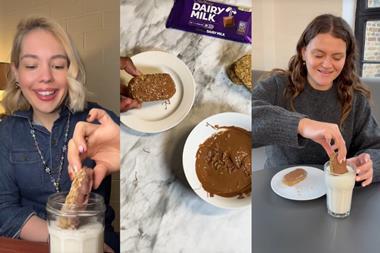They may be pricey and not have the best health credentials but chilled ready meals have flourished in the downturn, not least due to vigorous retailer NPD, says Catherine Chetwynd
Who'd have thought it? The one category you would put money on to struggle in a downturn chilled ready meals is in ruder health than ever.
Despite persistent consumer concerns about their relatively high price points and health credentials, they have posted 11.7% growth to £1.1bn over the past year and volume sales have leapt 16% [Kantar Worldpanel].
By contrast, frozen meals nosedived 22% in value to £437m between 2005 and 2010 [Mintel], their poor performance reflected in that of the top 10 ready meal brands (see right).
So how has the chilled market done so well? Well, convenience remains key and clearly shoppers are still prepared to shell out for something that they can cook in minutes over and above something that takes a long time to cook from frozen or needs first to be defrosted.
But another, arguably more important, factor is that unlike frozen, the chilled ready meals market is own-label dominated and retailers have really pushed the NPD envelope over the past year, particularly when it comes to the most popular cuisines: English, Italian and Indian.
The quality and authenticity of ready meals have improved dramatically and with good, better and best options also now available, there seems to be a ready meal to suit every taste and pocket.
English meals also tap into the recessionary trend for comfort foods, which may explain why they now account for 32.8% of the market. There's an element of patriotism, too, with supermarkets pushing traditional meals and consumers becoming increasingly interested in provenance.
"People want to buy English-style recipes," says Keith Gill, marketing and sales director and co-founder of Tanfield Food Company.
Across the sector as a whole, promotions have also played a significant role. So far, value sales growth has remained strong, but with the likes of Tesco depending heavily on X for Y deals, there is a danger that consumers have become so used to promotions that they no longer buy items at full price or even know what that price is.
"It is harder for customers to see how big a saving they are making because they don't know how much the item was originally," agrees Kantar analyst Robert Wade. "But a reduction such as 25% off drives trial, which is part of the idea."
It's also a win-win for the retailers as consumers feel they're getting a bargain, but even on promotion, chilled ready meals still generate good margins. And one of the most exciting growth areas, albeit from a low base, is French, with sales up 72.5% in value and 75.6% in volume [Kantar], thanks to some heavyweight premium NPD.
"Premium French products like Tesco's Restaurant Collection and Menu from Waitrose are trying to replicate classic restaurant dishes," says Sue Tiller, category director for meals at Kerry Foods.
Consumers are increasingly picking such meals as a treat, something to eat on a special occasion rather than going out and French is not the only cuisine to be benefiting from this premium push. Last year, Asda launched a range of ready meals under its Extra Special range. It's been a huge success, says ready meals buyer Joy McAlesse.
"We have seen more than 40% year-on-year growth on our Extra Special range, as the new lines raised the profile of our top tier brand and enabled us to bring new shoppers into the category."
Premium had hitherto been the one area in the chilled ready meals arena where the brands took the fight to own-label. Some brands continue to do well in this small sub-sector. Charlie Bigham's reports that since the brand's relaunch last year, sales has soared 45%.
The man behind the brand, Charlie Bigham, sees huge opportunity for growth. "Growth year-on-year is being driven at the premium end, where we sit," he says. "In two years, we can double our sales."
The market is also attracting exciting new players. Levi Roots ready meals were worth around £2.5m within 15 weeks of launch in May 2010, adding 80% incremental sales to the category, says manufacturer Kerry Foods. Cash and Carry, meanwhile, launched Authentic Kitchen in January.
And then, of course, there's Innocent, which has already seen its Veg Pots spawn a raft of own-label imitators. Tesco and M&S have launched Vegelicious and Lovely Vegetables respectively (see innovation panel, right) for consumers who are keen to eat less meat and are bored with sandwiches at lunchtime. Significantly, the latter includes snack pot variants.
"Since the launch of Innocent's veggie pots, we have seen competitors in chilled ready meals bring in pots, and all sorts of products have appeared in sandwich fixtures in big stores" says Katherine Roe, account director, grocery business insights at SymphonyIRI.
It is no coincidence that these products all boast better health credentials than the traditional HFSS ready meal. They are also perceived to be higher quality as, increasingly, is the whole chilled ready meal sector. Frozen, on the other hand, is struggling to convince consumers on the quality front and the level and depth of promotional activity has only served to exacerbate the problem.
"There is a price point beyond which consumers question ingredients," explains Greencore's head of prepared meals, Newby Groves.
No wonder Kerry Foods announced last week that it was closing its recently acquired Headlands Food Factory, claiming the own-label frozen ready meals market wasn't profitable enough.
Given the challenges involved with frozen, the focus is likely to remain on chilled and with household penetration currently standing at 77.1% [Kantar], there is still plenty of potential for growth especially for those that can give consumers the quality, authenticity and healthy ingredients they are looking for at the right price.
Whether the brands can loosen own-label's grip on the sector is another matter altogether.
Focus On Chilled Ready Meals
Who'd have thought it? The one category you would put money on to struggle in a downturn chilled ready meals is in ruder health than ever.
Despite persistent consumer concerns about their relatively high price points and health credentials, they have posted 11.7% growth to £1.1bn over the past year and volume sales have leapt 16% [Kantar Worldpanel].
By contrast, frozen meals nosedived 22% in value to £437m between 2005 and 2010 [Mintel], their poor performance reflected in that of the top 10 ready meal brands (see right).
So how has the chilled market done so well? Well, convenience remains key and clearly shoppers are still prepared to shell out for something that they can cook in minutes over and above something that takes a long time to cook from frozen or needs first to be defrosted.
But another, arguably more important, factor is that unlike frozen, the chilled ready meals market is own-label dominated and retailers have really pushed the NPD envelope over the past year, particularly when it comes to the most popular cuisines: English, Italian and Indian.
The quality and authenticity of ready meals have improved dramatically and with good, better and best options also now available, there seems to be a ready meal to suit every taste and pocket.
English meals also tap into the recessionary trend for comfort foods, which may explain why they now account for 32.8% of the market. There's an element of patriotism, too, with supermarkets pushing traditional meals and consumers becoming increasingly interested in provenance.
"People want to buy English-style recipes," says Keith Gill, marketing and sales director and co-founder of Tanfield Food Company.
Across the sector as a whole, promotions have also played a significant role. So far, value sales growth has remained strong, but with the likes of Tesco depending heavily on X for Y deals, there is a danger that consumers have become so used to promotions that they no longer buy items at full price or even know what that price is.
"It is harder for customers to see how big a saving they are making because they don't know how much the item was originally," agrees Kantar analyst Robert Wade. "But a reduction such as 25% off drives trial, which is part of the idea."
It's also a win-win for the retailers as consumers feel they're getting a bargain, but even on promotion, chilled ready meals still generate good margins. And one of the most exciting growth areas, albeit from a low base, is French, with sales up 72.5% in value and 75.6% in volume [Kantar], thanks to some heavyweight premium NPD.
"Premium French products like Tesco's Restaurant Collection and Menu from Waitrose are trying to replicate classic restaurant dishes," says Sue Tiller, category director for meals at Kerry Foods.
Consumers are increasingly picking such meals as a treat, something to eat on a special occasion rather than going out and French is not the only cuisine to be benefiting from this premium push. Last year, Asda launched a range of ready meals under its Extra Special range. It's been a huge success, says ready meals buyer Joy McAlesse.
"We have seen more than 40% year-on-year growth on our Extra Special range, as the new lines raised the profile of our top tier brand and enabled us to bring new shoppers into the category."
Premium had hitherto been the one area in the chilled ready meals arena where the brands took the fight to own-label. Some brands continue to do well in this small sub-sector. Charlie Bigham's reports that since the brand's relaunch last year, sales has soared 45%.
The man behind the brand, Charlie Bigham, sees huge opportunity for growth. "Growth year-on-year is being driven at the premium end, where we sit," he says. "In two years, we can double our sales."
The market is also attracting exciting new players. Levi Roots ready meals were worth around £2.5m within 15 weeks of launch in May 2010, adding 80% incremental sales to the category, says manufacturer Kerry Foods. Cash and Carry, meanwhile, launched Authentic Kitchen in January.
And then, of course, there's Innocent, which has already seen its Veg Pots spawn a raft of own-label imitators. Tesco and M&S have launched Vegelicious and Lovely Vegetables respectively (see innovation panel, right) for consumers who are keen to eat less meat and are bored with sandwiches at lunchtime. Significantly, the latter includes snack pot variants.
"Since the launch of Innocent's veggie pots, we have seen competitors in chilled ready meals bring in pots, and all sorts of products have appeared in sandwich fixtures in big stores" says Katherine Roe, account director, grocery business insights at SymphonyIRI.
It is no coincidence that these products all boast better health credentials than the traditional HFSS ready meal. They are also perceived to be higher quality as, increasingly, is the whole chilled ready meal sector. Frozen, on the other hand, is struggling to convince consumers on the quality front and the level and depth of promotional activity has only served to exacerbate the problem.
"There is a price point beyond which consumers question ingredients," explains Greencore's head of prepared meals, Newby Groves.
No wonder Kerry Foods announced last week that it was closing its recently acquired Headlands Food Factory, claiming the own-label frozen ready meals market wasn't profitable enough.
Given the challenges involved with frozen, the focus is likely to remain on chilled and with household penetration currently standing at 77.1% [Kantar], there is still plenty of potential for growth especially for those that can give consumers the quality, authenticity and healthy ingredients they are looking for at the right price.
Whether the brands can loosen own-label's grip on the sector is another matter altogether.
Focus On Chilled Ready Meals


















No comments yet